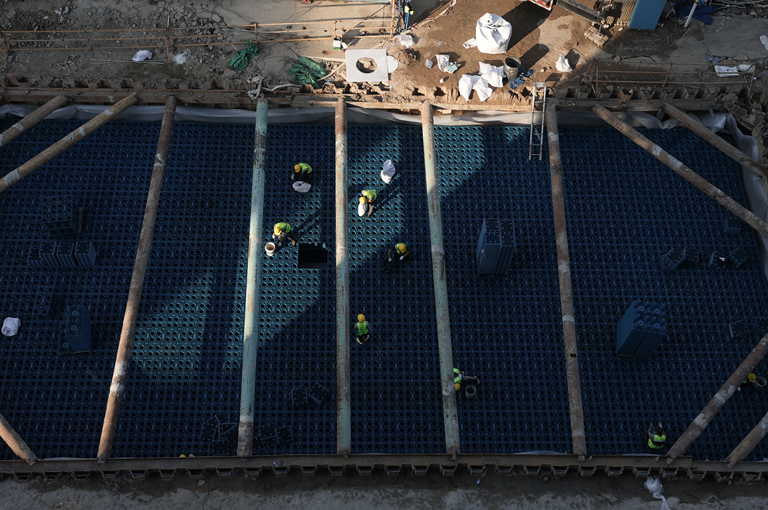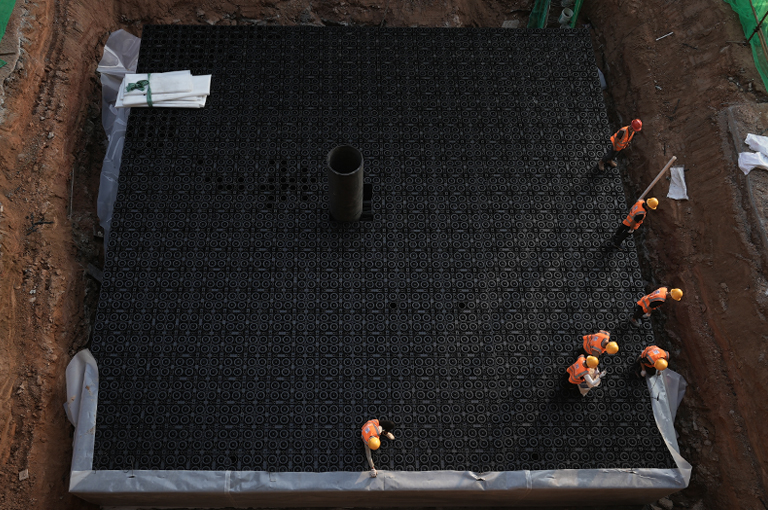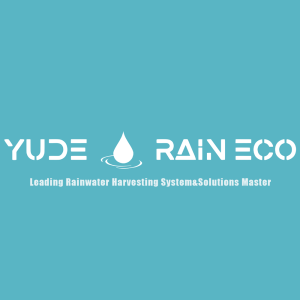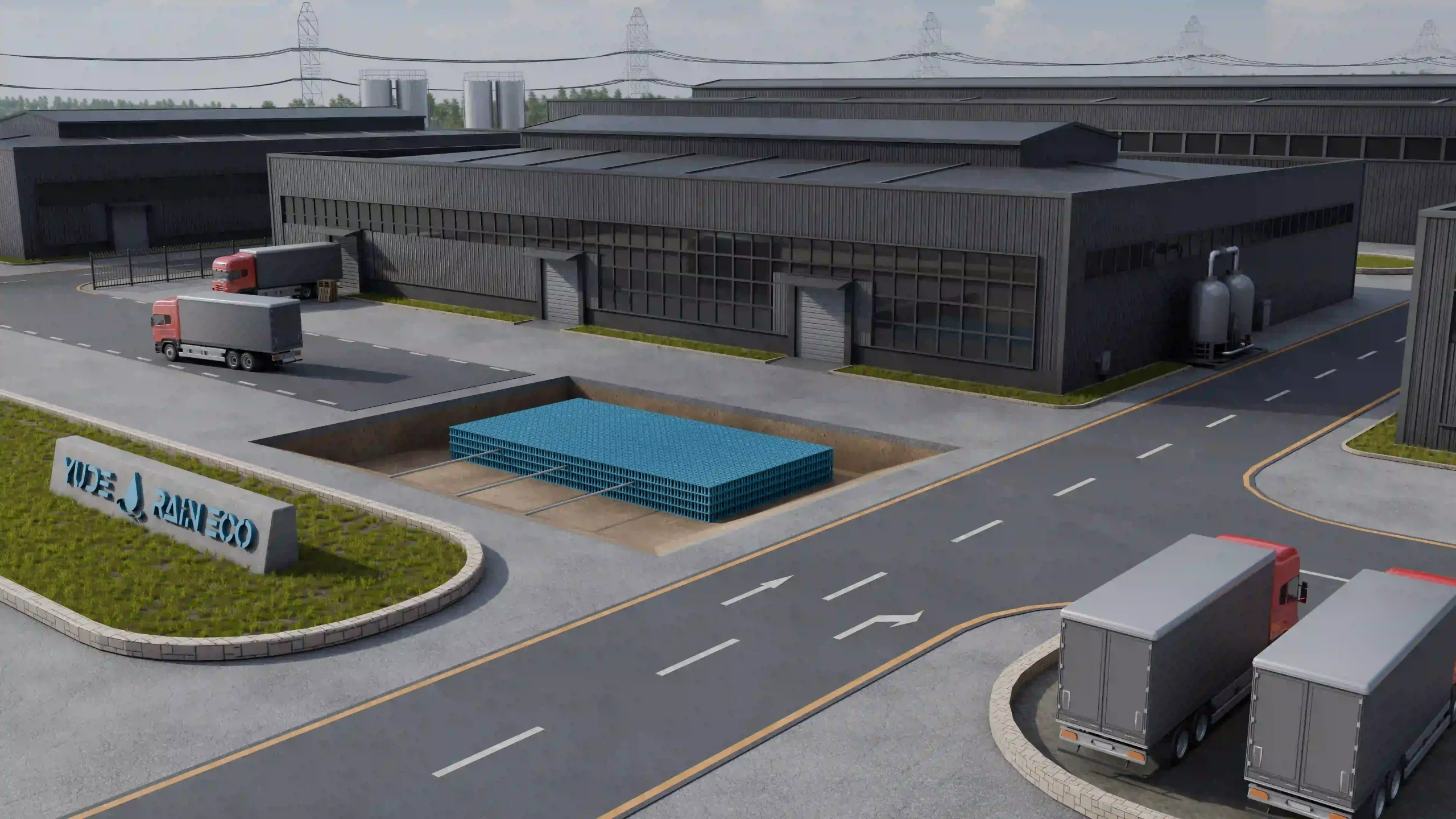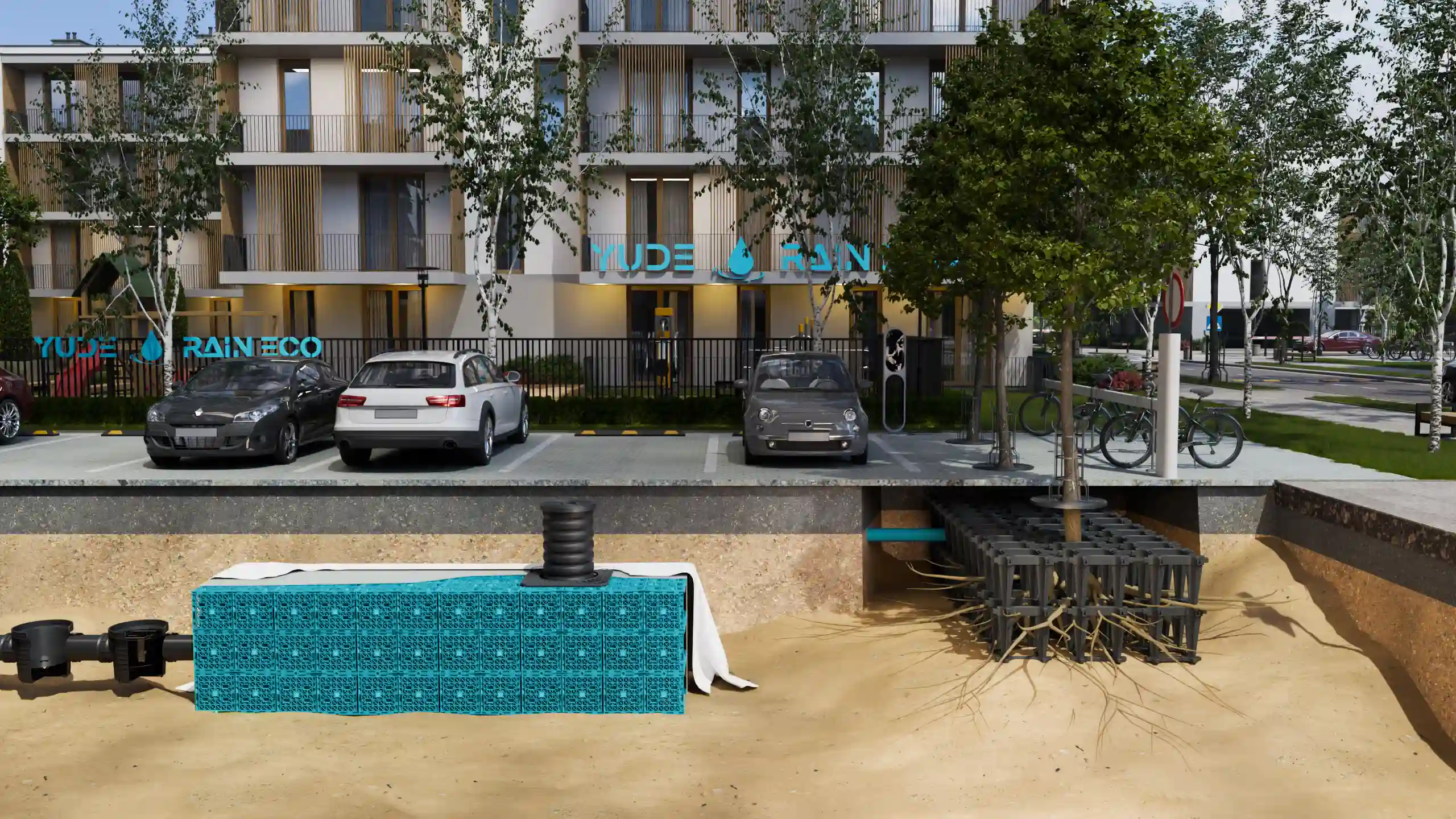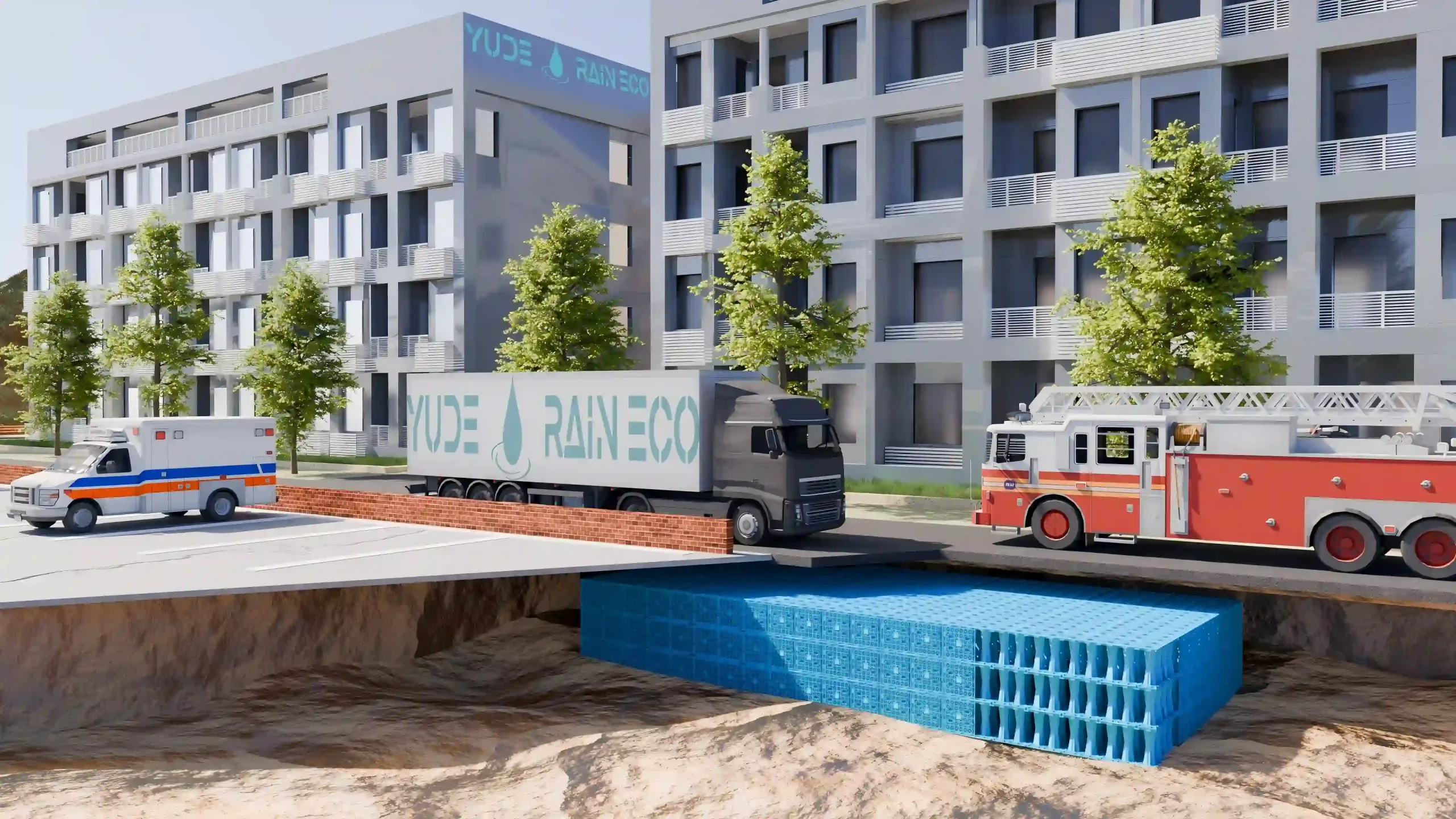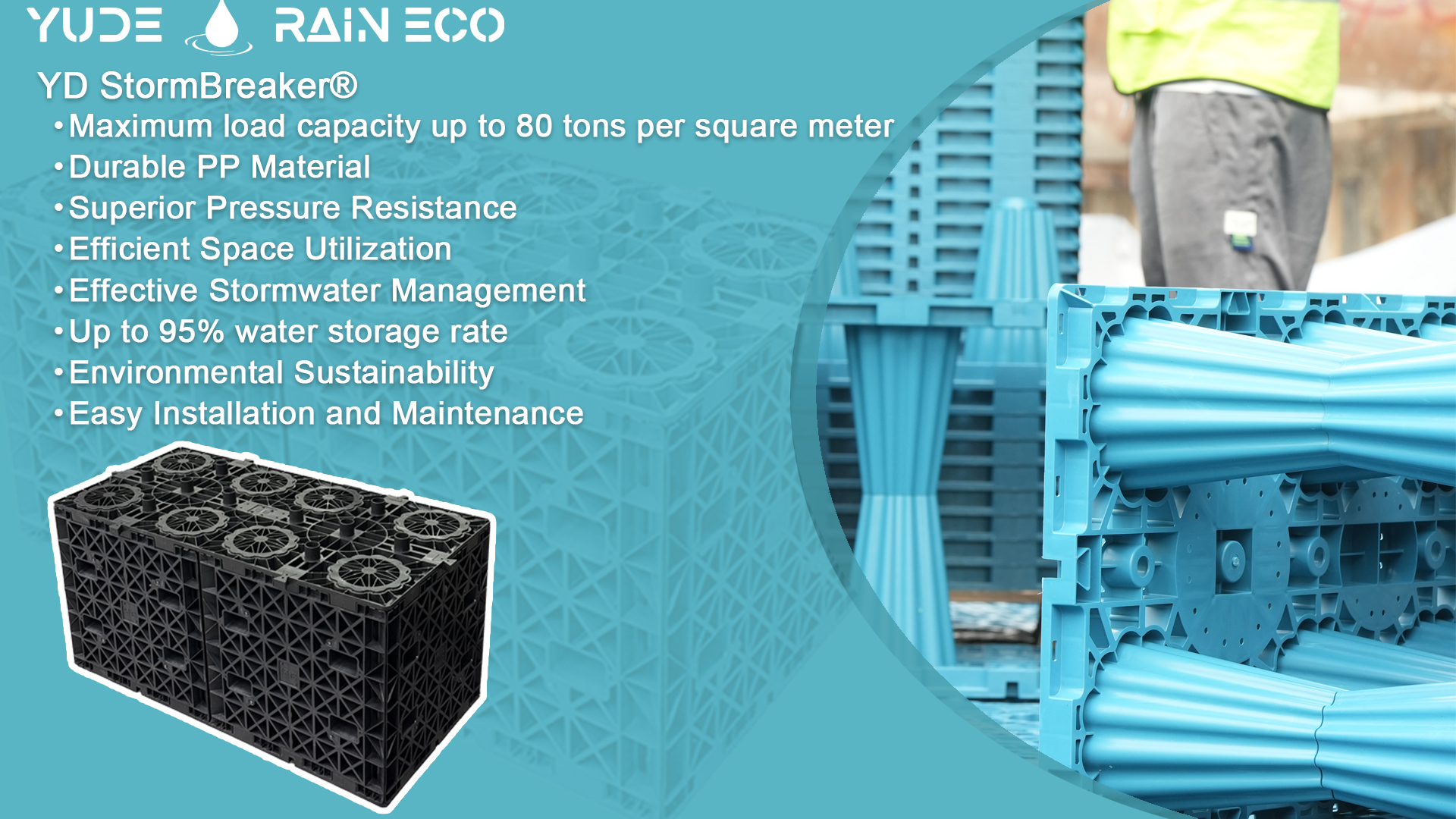In an era of rapid urbanization and increasing environmental challenges, effective stormwater management has become a critical concern for developers, engineers, and urban planners. Traditional drainage systems are often inadequate to handle the volume and intensity of modern rainfall events, leading to flooding, erosion, and water pollution. Enter geocellular attenuation tanks—also known as Geocellular Storage Tanks or Geocellular Attenuation Tanks—a revolutionary solution designed to address these challenges head-on.
Yude Rain Eco specialize in manufacturing and supplying high-performance geocellular attenuation tank systems that are transforming the way stormwater is managed worldwide. In this comprehensive guide, we’ll dive deep into the science, applications, and benefits of geocellular attenuation tanks, supported by real-world data and case studies, to provide you with the knowledge you need to make informed decisions for your projects.
As climate extremes become more frequent and urban expansion continues, geocellular attenuation tanks are no longer optional—they are a vital element of future-proof stormwater infrastructure.
Understanding geocellular attenuation tanks: What Are They?
Geocellular attenuation tanks are modular, underground structures made from high-density polyethylene (HDPE) or other durable materials. These tanks consist of interconnected cells that form a robust framework capable of storing large volumes of stormwater. Their design allows for efficient water collection, storage, and controlled release, making them an essential component of modern sustainable drainage systems (SuDS). These systems form part of a larger category known as below-ground stormwater attenuation or modular stormwater retention systems.
Their modular nature and adaptability make them ideal for Sustainable Drainage Systems (SuDS), low-impact developments (LIDs), and green infrastructure planning.
The terms Geocellular Storage Tanks and Geocellular Attenuation Tanks are often used interchangeably, but they highlight different functions:
- Storage Tanks: Focus on collecting and storing rainwater for reuse, such as irrigation or industrial processes.
- Attenuation Tanks: Designed to slow down the release of stormwater into drainage systems, reducing the risk of flooding and erosion.
The Science Behind Geocellular Attenuation Tanks
- Modular Design
geocellular attenuation tanks are composed of individual units that can be easily connected to form a larger system. This modularity allows for flexibility in design and scalability, making them suitable for projects of all sizes. - High Strength-to-Weight Ratio
Despite their lightweight construction, geocellular attenuation tanks are incredibly strong. The cellular structure distributes loads evenly, enabling them to withstand the pressure of soil and surface traffic without deformation. - Hydraulic Efficiency
The open structure of geocellular attenuation tanks ensures optimal water flow, minimizing the risk of blockages and maximizing storage capacity. This design also facilitates easy maintenance and cleaning. - Environmental Compatibility
Made from recyclable materials, geocellular attenuation tanks are an eco-friendly solution that aligns with green building standards and sustainability goals. Modern geocellular attenuation tanks are also compatible with filtration layers, silt traps, and pretreatment units, ensuring water quality management in addition to hydraulic control.
When integrated with smart monitoring devices, these systems can also support real-time flow management and predictive maintenance.
How Are Geocellular Attenuation Tanks Installed?
The installation of geocellular attenuation tanks is efficient, standardized, and scalable. Here’s a typical installation process:
-
Site Preparation
-
Soil investigation, load calculations, and geotextile planning
-
Excavation depth based on tank height + bedding layer
-
-
Base Layer Formation
-
A minimum 150 mm compacted gravel or sand bedding
-
Optional geomembrane layer for impermeable installations
-
-
Module Assembly
-
Modules are stacked and interlocked by hand or light machinery
-
Inspection chambers and flow controls are embedded during layout
-
-
Geotextile Wrapping
-
Full wrapping with non-woven geotextile (for infiltration) or geomembrane (for sealed storage)
-
-
Backfill and Surface Finishing
-
Backfilled in 300 mm layers
-
Surface restored to original condition: turf, paving, or asphalt
-
This process typically takes 1–3 days depending on project scale and weather conditions.
Applications of geocellular attenuation tanks
geocellular attenuation tanks are incredibly versatile and can be used in a wide range of applications, including:
Urban Development
- Residential Projects: Managing stormwater in housing developments, apartment complexes, and gated communities.
- Commercial Properties: Providing flood prevention and water reuse solutions for office buildings, shopping malls, and industrial parks.
Infrastructure Projects
- Roads and Highways: Preventing flooding and erosion along transportation corridors.
- Airports and Ports: Ensuring safe and efficient stormwater management in critical infrastructure.
Green Infrastructure
- Rainwater Harvesting: Collecting and storing rainwater for irrigation, cleaning, and other non-potable uses.
- Green Roofs and Walls: Integrating geocellular attenuation tanks with green building features to enhance sustainability.
Flood Prevention
- Flood-Prone Areas: Reducing the risk of flooding in vulnerable regions by attenuating stormwater flow.
- Coastal Zones: Protecting coastal communities from the impacts of heavy rainfall and rising sea levels.
Industrial Applications
- Manufacturing Facilities: Managing stormwater runoff from large industrial sites.
- Mining Operations: Preventing water contamination and erosion in mining areas.
Public Sector and Municipal Projects
-
Schools, hospitals, and government buildings: Managing rainwater on institutional campuses to meet sustainability mandates.
-
Parks and recreational areas: Providing discreet underground storage that preserves usable green space.
Benefits of geocellular attenuation tanks
Superior Storage Capacity
geocellular attenuation tanks offer a high storage volume relative to their footprint, making them ideal for space-constrained projects. Their modular design allows for customization to meet specific storage requirements.
Durability and Longevity
Constructed from high-quality materials, geocellular attenuation tanks are resistant to corrosion, chemicals, and environmental stressors. They have a lifespan of 50 years or more, ensuring long-term performance and reliability.
Cost-Effectiveness
- Reduced Infrastructure Costs: By managing stormwater onsite, geocellular attenuation tanks reduce the need for expensive drainage infrastructure upgrades.
- Lower Maintenance Costs: Their robust design and self-cleaning properties minimize maintenance requirements.
- Efficient Installation: Lightweight components and modular construction reduce installation time and labor costs.
Environmental Sustainability
- Water Conservation: Capturing and reusing stormwater reduces demand on municipal water supplies.
- Ecosystem Protection: By attenuating stormwater flow, geocellular attenuation tanks help prevent erosion and protect aquatic habitats.
- Carbon Footprint Reduction: Using recyclable materials and promoting water reuse contributes to lower carbon emissions.
Regulatory Compliance
geocellular attenuation tanks help developers and property owners comply with local and international stormwater management regulations, avoiding fines and legal issues.
Climate Resilience
Geocellular attenuation tanks support urban climate adaptation strategies by reducing flood risk, mitigating heat island effects (when paired with green roofs), and ensuring stormwater resilience during extreme rainfall events.
Environmental & Economic Impact Analysis – Cost and Sustainability Benefits Over Time
Compared to traditional systems (e.g. concrete tanks, detention ponds), geocellular attenuation tanks deliver:
-
Lower Upfront Cost: 20–30% savings due to modular, lightweight material and faster install
-
Minimal Maintenance: No internal corrosion, easy access via inspection ports
-
Reduced Lifecycle Carbon Emissions: Made from recycled plastics, transport-optimized
-
Improved ROI: Operational water reuse, flood prevention savings, and stormwater fee rebates
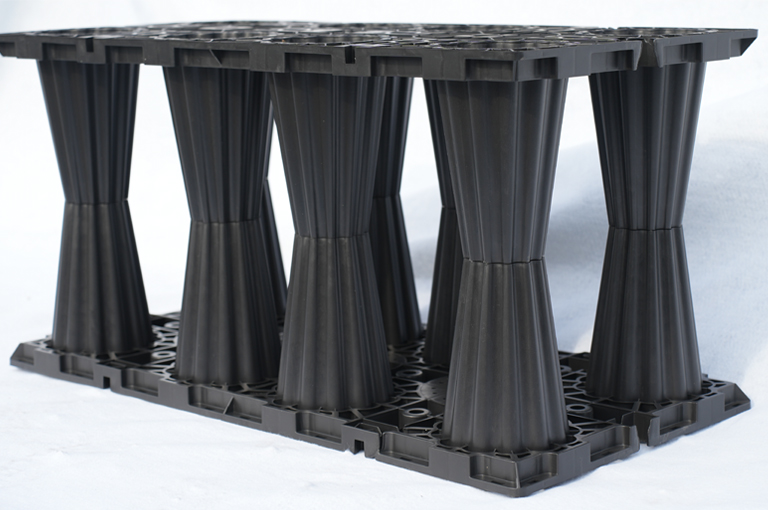
Case Studies: Real-World Applications of Geocellular Attenuation Tanks
1. Urban Redevelopment Project in Europe
A major city in Europe faced frequent flooding due to outdated drainage systems. By installing geocellular attenuation tanks beneath a new residential complex, the city was able to reduce flood risk, improve water quality, and create additional green space for residents.
Data Point: The project resulted in a 30% reduction in flood incidents and a 20% increase in green space within the first year of implementation.
2. Industrial Park in Asia
A large industrial park in Asia struggled with stormwater runoff from its manufacturing facilities. The installation of geocellular storage tanks allowed the park to collect and reuse rainwater for cooling and cleaning processes, reducing water costs and environmental impact.
Data Point: The industrial park reported a 40% reduction in water consumption and a 25% decrease in operational costs related to water management.
3. Highway Expansion in North America
A highway expansion project in North America required a solution to prevent erosion and flooding along the new route. geocellular attenuation tanks were installed beneath the road surface, providing effective stormwater management without disrupting traffic flow.
Data Point: The project achieved a 50% reduction in erosion-related maintenance costs and a 15% improvement in road safety during heavy rainfall events.
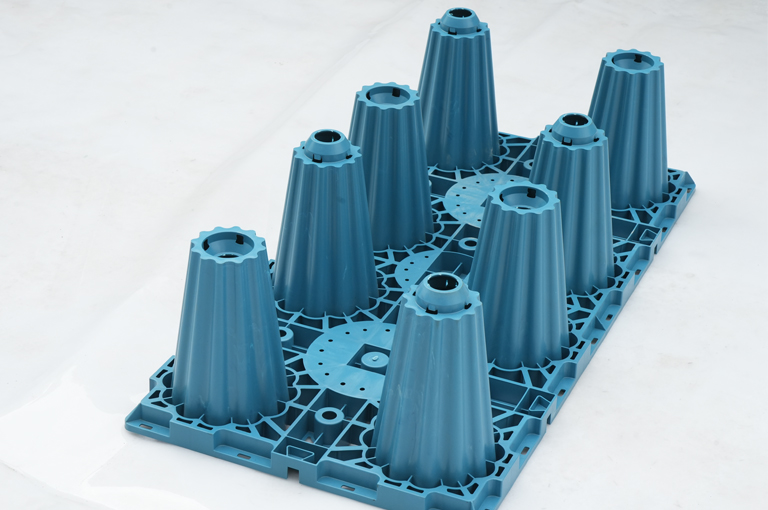
Choosing the Right Geocellular Attenuation Tank System
When selecting a geocellular attenuation tank system for your project, consider the following factors:
- Project Requirements
- Storage capacity
- Site conditions (e.g., soil type, water table)
- Regulatory requirements
- Product Quality
- Material durability
- Load-bearing capacity
- Hydraulic efficiency
- Supplier Expertise
- Industry experience
- Technical support
- Customization capabilities
- System Certification
Look for systems that comply with international standards such as BS EN 17152, CIRIA SuDS Manual, or ISO 9001-certified manufacturing.
Third-party tested load performance and hydraulic efficiency reports add further assurance for engineers and developers.
Yude Rain Eco offer a wide range of geocellular attenuation tank systems tailored to meet the unique needs of your project. Our team of experts is available to provide guidance and support at every stage, from design to installation.
Selecting the Right System for Your Sector: Use-Case Based Comparison
For Urban Developers & Civil Engineers
In fast-developing urban areas, stormwater management must be both space-efficient and regulation-compliant. Geocellular attenuation tanks offer:
-
Reduced site footprint with underground installation
-
Compliance with SuDS, BS EN 17152, ISO 9001
-
Easy integration with permeable pavements, infiltration trenches, and green spaces
For Commercial and Industrial Sites
Large rooftops and paved zones lead to intense runoff. YudeRainEco’s heavy-duty attenuation tanks are ideal for:
-
Fire lanes, logistics yards, and vehicle parking zones
-
Dual use: flood control + rainwater harvesting for washdown or cooling
-
Load-tested modules for 32t, 45t, 60t ratings
For Government Projects and Institutions
Hospitals, schools, and public parks increasingly demand infrastructure that aligns with:
-
Sustainability goals (LEED, BREEAM, WELL)
-
Budget-conscious installation
-
Low long-term maintenance
Our tanks enable decentralized, reliable drainage in these settings—without disrupting existing infrastructure.
Frequently Asked Questions (FAQs)
- What is the lifespan of a geocellular attenuation tank?
geocellular attenuation tanks typically have a lifespan of 50 years or more, depending on the material and installation conditions. - Can geocellular attenuation tanks be installed under heavy traffic areas?
Yes, geocellular attenuation tanks are designed to withstand heavy loads and can be installed beneath roads, parking lots, and other high-traffic areas. - How do geocellular attenuation tanks compare to traditional stormwater management systems?
geocellular attenuation tanks offer superior storage capacity, durability, and environmental benefits compared to traditional systems like concrete tanks or open drainage channels. - Are geocellular attenuation tanks suitable for rainwater harvesting?
Absolutely! geocellular attenuation tanks are an excellent choice for rainwater harvesting, providing a reliable and efficient way to collect and store water for reuse.
Why Choose Yude Rain Eco?
As a leading manufacturer and supplier of geocellular attenuation tanks, Yude Rain Eco is committed to delivering innovative, high-quality solutions that meet the highest international standards. Our products are trusted by clients worldwide for their reliability, performance, and environmental benefits.
- Global Reach: We serve clients in over 50 countries, providing reliable shipping and technical support.
- Custom Solutions: Our team works closely with you to design systems that meet your specific needs.
- Sustainability Focus: We prioritize eco-friendly materials and practices in everything we do.
- Our geocellular attenuation tanks have been used in over 1,000 projects globally, from smart city stormwater systems to industrial parks, proving their durability, versatility, and engineering value.
We also offer BIM models, CAD support, and hydrological simulations to ensure seamless project integration.
Ready to Build Smarter Stormwater Solutions?
Whether you’re designing a new development or upgrading outdated infrastructure, Yude Rain Eco’s geocellular attenuation tank systems deliver scalable, compliant, and future-ready solutions.
Need help selecting the right configuration?
Our engineering team offers end-to-end design support—from concept to installation.
Looking for supply assurance?
Our products are stocked and shipped globally, with responsive support available in over 50 countries.
- Customized system design and technical support
Reliable global delivery and logistics
Proven performance across 1,000+ real-world projects
Let’s talk about how we can support your stormwater management goals:
Contact our technical team: [email protected]
Explore specs, case studies, and FAQs: www.yuderaineco.com
Invest in efficient, sustainable, and compliant drainage systems—choose Yude Rain Eco.
FAQ
Q: How do geocellular attenuation tanks support sustainable drainage design (SuDS)?
A:These tanks allow stormwater to be stored temporarily and released gradually, mimicking natural infiltration processes. They help meet SuDS criteria by reducing peak discharge, promoting groundwater recharge (in permeable systems), and enabling rainwater reuse.
Q: What is the difference between modular attenuation crates and geocellular tanks?
A:They are often used interchangeably. Modular attenuation crates are the building blocks of geocellular tanks, which are the full system constructed from these interlocking units. Both refer to underground systems for stormwater detention and attenuation.
Q: Can geocellular attenuation tanks be integrated with permeable pavements or infiltration systems?
A:Yes. When used with permeable surfaces and geotextile membranes, geocellular tanks can facilitate water infiltration into the subsoil, aiding groundwater recharge and reducing runoff.
Q: Can geocellular attenuation tanks be used in retrofitting old urban drainage systems?
A: Yes. Their modular and lightweight structure makes them ideal for space-limited, retrofit projects where traditional drainage upgrades are infeasible.
Q: What are the regulatory benefits of using geocellular attenuation tanks?
A: Yude’s systems help meet international standards like SuDS, LEED, ISO 9001, and BS EN 17152. They can also contribute to local stormwater credits or green infrastructure incentives.
Q: How are Yude’s attenuation tanks shipped internationally?
A: All crates are flat-packed and container-optimized. Yude offers sea or air freight, with support in over 50 countries, including remote design supervision and local partner networks.

